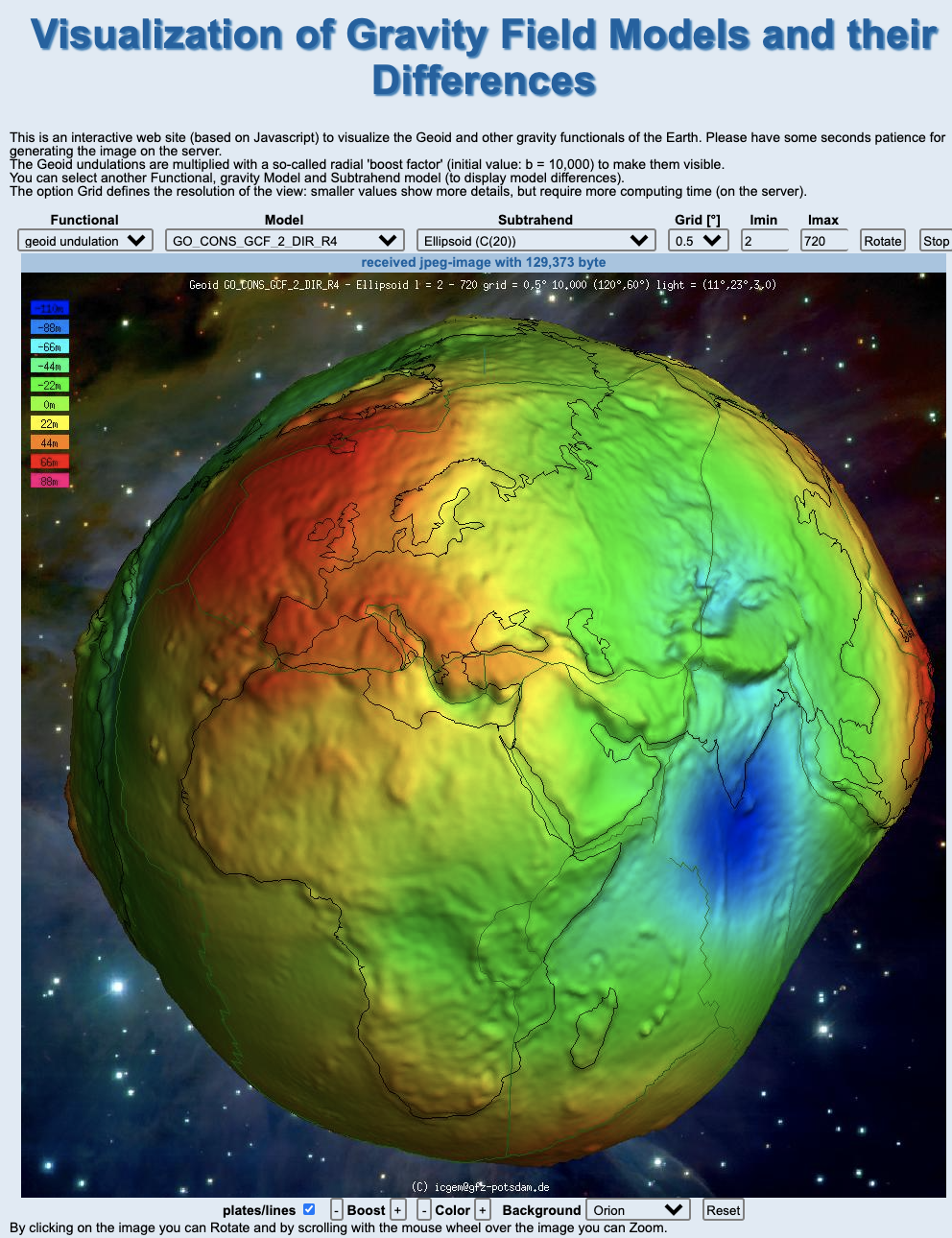Global gravity field model Geoid: EIGEN-6C4

Topics
- Access
- Description
- Parameters
- Coverage, spatial and temporal resolution
- Data quality
- Contact person
- References
- Data citation
Access
UNRESTRICTED:
Description
EIGEN-6C4 is a high-resolution global gravity field model. It is one of the first EIGEN (European Improved Gravity model of the Earth by New techniques) combination model that includes GOCE data. Its role is fundamental in geodesy and Earth sciences and ranges from practical purposes, like orbit determination, to scientific applications, like the investigation of the density structure of the Earth's interior. The new EIGEN released in 2014 is called EIGEN-6C4 and has been created from a combination of a multitude of data (see International Centre for Global Earth Models Website in references).
Last update of data set at ICDC:
Parameters
| Name | Unit |
|---|---|
| Geoid model | - (Spherical Harmonics Coefficients) |
Coverage, spatial and temporal resolution
Period and temporal resolution:
- Release 2014
- 1 map
Coverage and spatial resolution:
- Global
- Spatial resolution: up to degree/order 2190, about 9 km
- Geographic longitude: 180°W to 180°E
- Geographic latitude: 90°S to 90°N
- Dimension: depends on degree / order of the development of the spherical harmonics
Format:
- ASCII (Gravity Field Coefficient - GFC Format: Degree, Order, 2 spherical harmonics coefficients)
Data quality
The geoid height differences between EIGEN-6C4 and EGM2008 indicates that the gravity field modeling is enhanced by the new GOCE data. The EIGEN-6C4 "corrects" the EGM2008, mainly over continent parts with bad terrestrial data coverage. The new combined gravity field model has been evaluated by GOCE orbit computations, GPS-Leveling comparisons and by comparisons in the spatial domain. The GPS-Leveling comparisons indicate that EIGEN-6C4 is almost the same performance as EGM2008 for the short wavelenghts. In the orbit test results the time variable EIGEN-6C4 gives the best results.
EIGEN-6C4 improves the orbit computation compared to GRACE models. The improved resolution is due to improved and new methods of satellite measurements (e.g SLR, GPS and K-Band Ranging), satellite gradiometry, the increased accuracy in the measurement of surface data and long-term data series.
More information is given in the references.
Contact
Christoph Förste
GFZ Potsdam
email: foer (at) gfz-potsdam.deRichard Biancale
Groupe de Recherches de Geodesie Spatiale / CNES
email: richard.biancale (at) cnes.frStefan Kern
ICDC / CEN / University of Hamburg
E-Mail: stefan.kern"AT"uni-hamburg.de
References
Literature:
- Foerste, Christoph; Bruinsma, Sean.L.; Abrikosov, Oleg; Lemoine, Jean-Michel; Marty, Jean Charles; Flechtner, Frank; Balmino, G.; Barthelmes, Franz; Biancale, Richard (2014): EIGEN-6C4 The latest combined global gravity field model including GOCE data up to degree and order 2190 of GFZ Potsdam and GRGS Toulouse. GFZ Data Services. https://doi.org/10.5880/icgem.2015.1
Websites:
- Website from the "International Geoid Service" (IGeS) http://icgem.gfz-potsdam.de/
- International Centre for Global Earth Models, https://dataservices.gfz-potsdam.de/icgem/showshort.php?id=escidoc:1119897
Data citation
Please cite the data as follows:
Foerste, Christoph; Bruinsma, Sean.L.; Abrikosov, Oleg; Lemoine, Jean-Michel; Marty, Jean Charles; Flechtner, Frank; Balmino, G.; Barthelmes, Franz; Biancale, Richard (2014): EIGEN-6C4 The latest combined global gravity field model including GOCE data up to degree and order 2190 of GFZ Potsdam and GRGS Toulouse. GFZ Data Services. https://doi.org/10.5880/icgem.2015.1
and with the following acknowledgments:
Thanks to ICDC, CEN, University of Hamburg for data support.
